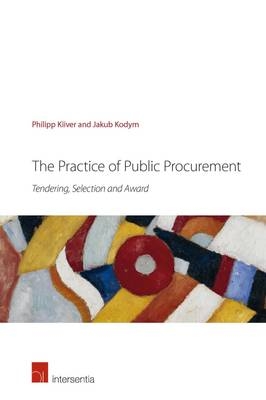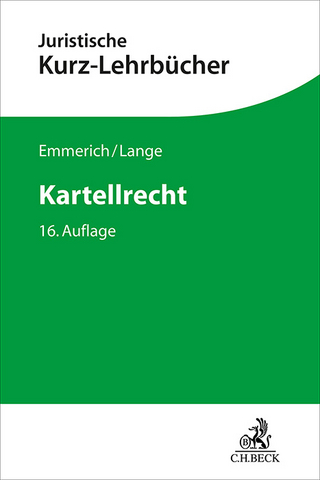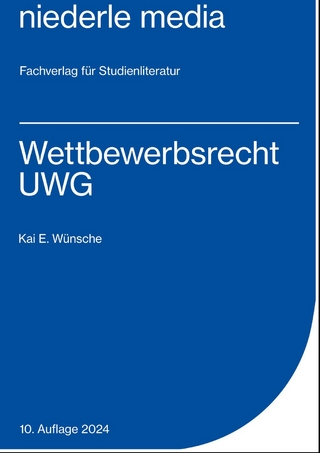
The Practice of Public Procurement
Intersentia Ltd (Verlag)
978-1-78068-266-2 (ISBN)
- Keine Verlagsinformationen verfügbar
- Artikel merken
About the authors Philipp Kiiver was born in 1979 in Leningrad. He obtained his law degree and his PhD from Maastricht University. From 2003 to 2013 he taught European and comparative public law and published academic research at the Maastricht law faculty, receiving an appointment as associate professor and serving for two years as associate dean. In 2013 he joined the European Parliament as a public procurement lawyer. Jakub Kodym was born in 1978 in Prague. After studies in political science and in economics at Charles University in Prague (M.A.), management studies at Nantes University (MBA), and private sector experience, he joined the EU institutions in 2007 and worked as a CGAP certified internal auditor for the European Commission and, since 2011, as a procurement officer in the European Parliament.
Philipp Kiiver was born in 1979 in Leningrad. He obtained his law degree and his PhD from Maastricht University. From 2003 to 2013 he taught European and comparative public law and published academic research at the Maastricht law faculty, receiving an appointment as associate professor and serving for two years as associate dean. In 2013 he joined the European Parliament as a public procurement lawyer. Jakub Kodym was born in 1978 in Prague. After studies in political science and in economics at Charles University in Prague (M.A.), management studies at Nantes University (MBA), and private sector experience, he joined the EU institutions in 2007 and worked as a CGAP certified internal auditor for the European Commission and, since 2011, as a procurement officer in the European Parliament.
CONTENTS Table of Cases Table of Figures Chapter 1. Introduction 1.1. The Tendering Procedure 1.2. Selection Criteria 1.3. Technical Specifications 1.4. Award Criteria 1.5. European Union Law 1.6. Sound Financial Management Chapter 2. The Tendering Procedure 2.1. Advertisement 2.2. Publication of Tender Documents 2.3. The Style of Tender Documents 2.4. Publishing the Contract Value Estimate 2.5. Questions and Answers 2.6. Visits to the Premises 2.7. Deadlines 2.8. Transmission Formalities 2.9. Exclusion Criteria 2.10. The Length of Validity of Tenders Chapter 3. Technical Specifications 3.1. Technical Requirements 3.2. Market Research 3.3. Variants 3.4. Options 3.4.1. Dissociated Options 3.4.2. Associated Options 3.4.3. Lock-In Options 3.4.4. Obligation to Tender for Options 3.5. Parallel Tenders Chapter 4. Selection Criteria 4.1. The EU Legal Framework 4.2. The Logic of Selection Criteria 4.3. Financial Capacity 4.3.1. Accounting Principles 4.3.2. Turnover 4.3.3. Net and Gross Earnings 4.3.4. Economic Viability 4.3.5. Insurance 4.3.6. Overview 4.4. Technical Capacity 4.5. Consortia 4.5.1. The Professional Capacity of Consortia 4.5.2. The Financial Capacity of Consortia 4.6. Subcontractors 4.7. Favouring the Usual Suspects Chapter 5. Award Methods 5.1. Single and Multiple Award Criteria 5.2. Lowest Price 5.3. Lowest Cost 5.4. Price-Quality Ratio 5.5. Electronic Auctions 5.6. Negotiations 5.7. The Pros and Cons of Different Award Methods Chapter 6. The Price Schedule 6.1. Total Price 6.2. Consumption Models 6.3. The Value of Awards with Consumption Models 6.4. The Importance of Accurate Estimates 6.5. Adjusting to Different Pricing Policies 6.6. Including Cost in the Price 6.7. Price Indexation 6.7.1. The Logic of Indexation 6.7.2. Automatic and Manual Price Adjustment 6.7.3. Upward and Downward Adjustment 6.7.4. To Index or not to Index 6.7.5. The Choice of an Appropriate Index Chapter 7. Qualitative Award Criteria 7.1. The Choice of Award Criteria 7.2. Quality Verification 7.3. Cost as a Quality Criterion Chapter 8. The Price-Quality Ratio 8.1. Price-Quality Ratios and Other Formulas 8.2. Quality Divided by Price 8.3. Adjusting for Criteria Weighting 8.3.1. The Baseline Quality Score 8.3.2. The Proportion of Extra Spending 8.3.3. Adjusting the Scales 8.4. Multiple Award Criteria 8.5. Multiple Objects 8.6. Global Quality and Minimum Quality Thresholds 8.7. The Dilemma of High Quality Standards 8.8. On the Neutralization of the Price Criterion 8.9. The Importance of Knowing what You Want 8.10. Defining Quality in Public Procurement Chapter 9. Quality Assessment 9.1. Binary Criteria 9.2. Quantitative Criteria 9.3. Non-Binary Qualitative Criteria 9.4. Point Inflation 9.5. Assessment Grids Chapter 10. Choice of Procedure 10.1. Open Procedures 10.2. Restricted Procedures 10.3. Negotiated Procedures 10.4. Exceptional Procedures Chapter 11. The Post-Award Stage 11.1. The Duty to State Reasons 11.2. Evaluation and Follow-Up Chapter 11. The Post-Award Stage 11.1. The Duty to State Reasons 11.2. Evaluation and Follow-Up Chapter 12. Green Procurement Chapter 13. Managing the Risk of Irregularities and Inefficiencies 13.1. Irregularities in Public Procurement 13.2. The Inefficiency of Reduced Competition 13.3. Risk Management and Continuous Improvement of the Procurement Process 13.4. Procurement Risks and Risk Response Chapter 14. Conclusions Appendix I. The Assessment of the Economic Viability of Companies Appendix II. Mathematical Discussion of Formulas to Determine Price-Quality Ratios References Index
| Erscheint lt. Verlag | 4.11.2014 |
|---|---|
| Verlagsort | Cambridge |
| Sprache | englisch |
| Maße | 160 x 240 mm |
| Gewicht | 300 g |
| Themenwelt | Recht / Steuern ► EU / Internationales Recht |
| Recht / Steuern ► Wirtschaftsrecht ► Wettbewerbsrecht | |
| ISBN-10 | 1-78068-266-2 / 1780682662 |
| ISBN-13 | 978-1-78068-266-2 / 9781780682662 |
| Zustand | Neuware |
| Haben Sie eine Frage zum Produkt? |
aus dem Bereich


